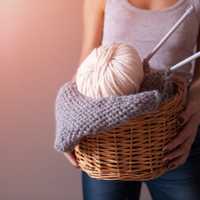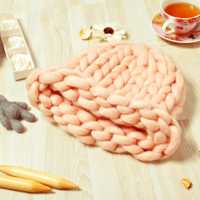Creative Knitting - Dyeing Naturally!
By Linda Black
By Linda Black
Knitting with a yarn that you have dyed to match your own exact colour needs is a truly creative knitting experience.
Better still, dyeing your yarn with natural materials you have collected yourself means that your finished item is totally unique and highly personalised.
Although it's more time-consuming and more expensive to use natural dyes rather than using synthetic dyes, most people find that the colours which result from the use of vegetables and plants as dyes are subtler and more alive than their artificial equivalents.
Historically, natural dyes were used extensively and the quality of colours that our ancestors were able to produce can be seen in Museums throughout the world. Since the first chemical dye did not make an appearance until the mid 1850s, any textile dated before then can be credited to the use of natural dyes.
The natural materials for dyes are sometimes difficult and time-consuming to collect in enough quantity and, if purchased, cost more than synthetic dyes. Certainly the recipes used are often complicated and the results can be unpredictable. The time of year that the materials were collected, the climatic conditions and type of soil in which the materials grew can all affect the final colour achieved.
Natural dyes can be divided into two categories - adjective dyes and substantive dyes.
Adjective dyes have to be used in conjunction with a mordant to make them colour fast, whilst substantive dyes will produce a fast colour on their own.
If you don't want to collect your own plants, natural dye materials can be obtained from chemists or good craft or specialist shops.
If you do collect your own materials, they should be taken from young, healthy plants. Lichens, which used to be used in the dyeing of tartans, should be collected from stones and the barks of trees after a substantial rainfall and, preferably, in the winter. Used fresh the colour will be more vivid than if the materials are dried and stored.
The general rule for collecting dye materials is to allow the same weight of material as the weight of yarn to be dyed.
It's also a comfort to remember that your yarn can always be redyed, either to change an unintended, unpleasant colouring or as a deliberate strategy to create a particular colour or effect.
Dyeing yarn using natural dyes is becoming more popular as a craft and there are lots of books available on the subject as well as, in some areas, courses and classes.
Copyright 2006 Linda Black
Based in the UK, Linda Black has written several design books for machine knitters and is a self-confessed knitting addict. Her web site for both hand and machine knitters can be found at http://www.getknitting.com Sign up for her free monthly knitting hints and tips newsletter here
Article Source: http://EzineArticles.com/?expert=Linda_Black
Knitting with a yarn that you have dyed to match your own exact colour needs is a truly creative knitting experience.
Better still, dyeing your yarn with natural materials you have collected yourself means that your finished item is totally unique and highly personalised.
Although it's more time-consuming and more expensive to use natural dyes rather than using synthetic dyes, most people find that the colours which result from the use of vegetables and plants as dyes are subtler and more alive than their artificial equivalents.
Historically, natural dyes were used extensively and the quality of colours that our ancestors were able to produce can be seen in Museums throughout the world. Since the first chemical dye did not make an appearance until the mid 1850s, any textile dated before then can be credited to the use of natural dyes.
The natural materials for dyes are sometimes difficult and time-consuming to collect in enough quantity and, if purchased, cost more than synthetic dyes. Certainly the recipes used are often complicated and the results can be unpredictable. The time of year that the materials were collected, the climatic conditions and type of soil in which the materials grew can all affect the final colour achieved.
Natural dyes can be divided into two categories - adjective dyes and substantive dyes.
Adjective dyes have to be used in conjunction with a mordant to make them colour fast, whilst substantive dyes will produce a fast colour on their own.
If you don't want to collect your own plants, natural dye materials can be obtained from chemists or good craft or specialist shops.
If you do collect your own materials, they should be taken from young, healthy plants. Lichens, which used to be used in the dyeing of tartans, should be collected from stones and the barks of trees after a substantial rainfall and, preferably, in the winter. Used fresh the colour will be more vivid than if the materials are dried and stored.
The general rule for collecting dye materials is to allow the same weight of material as the weight of yarn to be dyed.
It's also a comfort to remember that your yarn can always be redyed, either to change an unintended, unpleasant colouring or as a deliberate strategy to create a particular colour or effect.
Dyeing yarn using natural dyes is becoming more popular as a craft and there are lots of books available on the subject as well as, in some areas, courses and classes.
Copyright 2006 Linda Black
Based in the UK, Linda Black has written several design books for machine knitters and is a self-confessed knitting addict. Her web site for both hand and machine knitters can be found at http://www.getknitting.com Sign up for her free monthly knitting hints and tips newsletter here
Article Source: http://EzineArticles.com/?expert=Linda_Black



